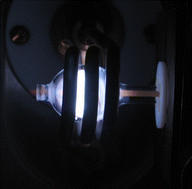Based on the static high sensitivity inductively coupled plasma (SHIP) introduced by Buscher et al. (W. Buscher, A. Klostermeier, C. Engelhard, S. Evers, M. Sperling, J. Anal. At. Spectrom., 2005, 20, 308-314), a new torch design for ICP mass spectrometry was developed. The SHIP-torch, including the external air cooling system, was modified in order to allow its application as an ion source in a conventional ICP mass spectrometer. While the torch geometry was adjusted for its use in connection with the sampling interface, the principal shape of the torch remained the same as in the recently developed SHIP-OES-system. The plasma discharge was operated at 0.65 kW rf power with a total plasma gas flow rate of 1.95 L min−1 and the mass spectrum was investigated. A standard pneumatic nebuliser was used as sample introduction system and the ion signals of a multi elemental standard solution were measured for different sample carrier gas flow rates from 0.2 to 1.4 L min−1. Limits of detection were obtained for a number of elements. These results were compared to those achieved with the conventional ICP-MS setting.

You have access to this article
 Please wait while we load your content...
Something went wrong. Try again?
Please wait while we load your content...
Something went wrong. Try again?


 Please wait while we load your content...
Please wait while we load your content...